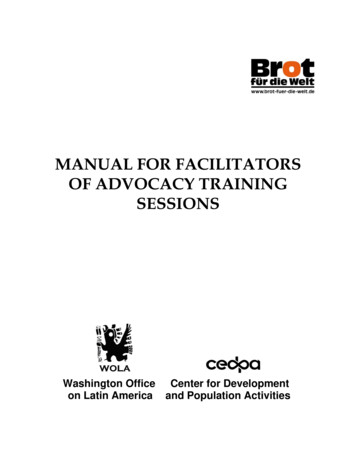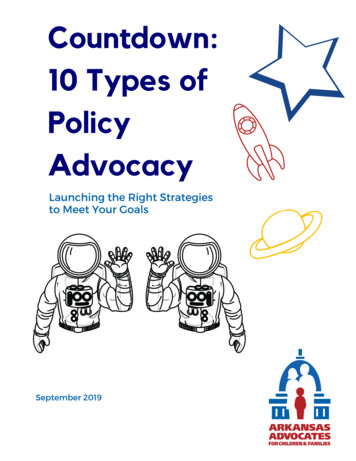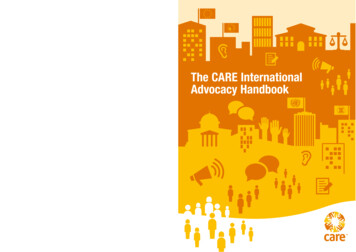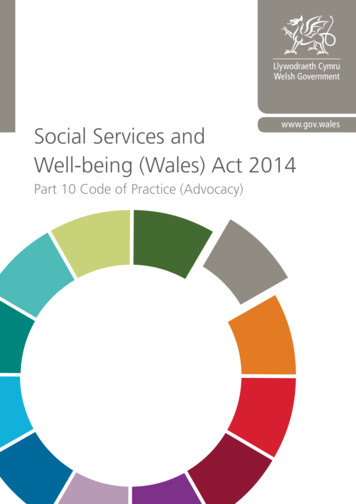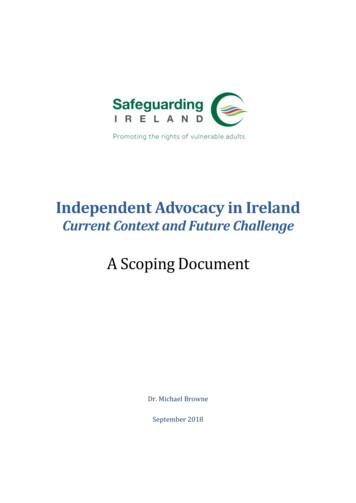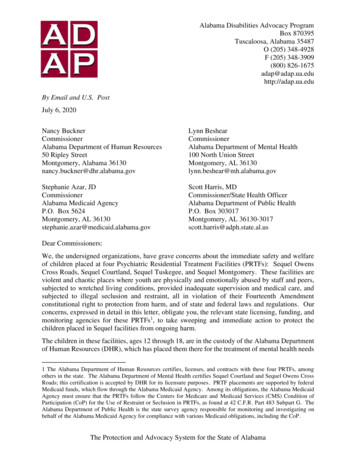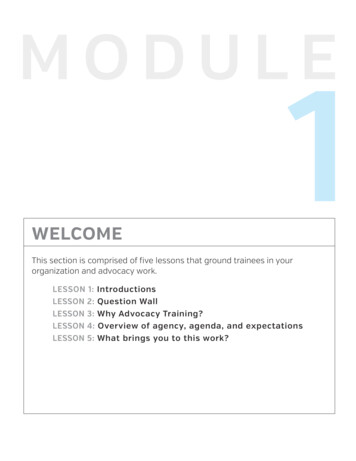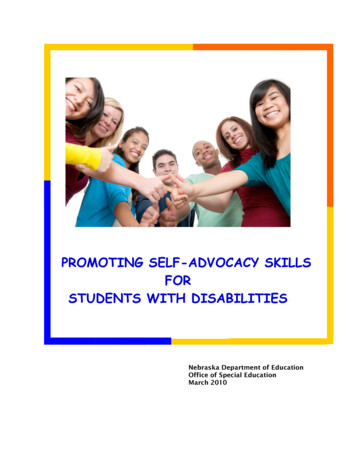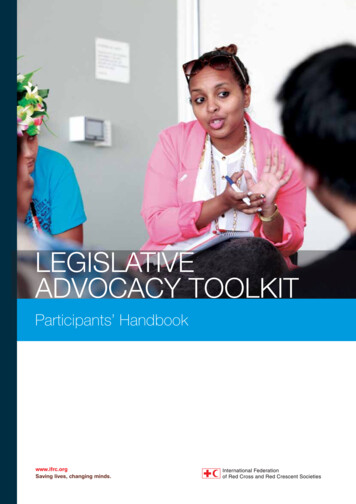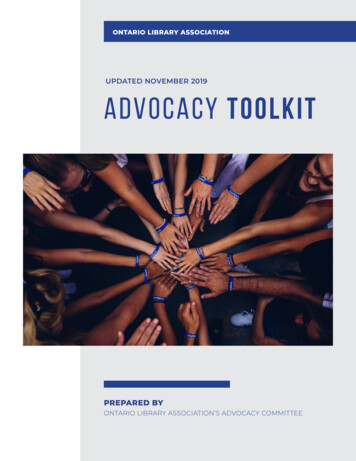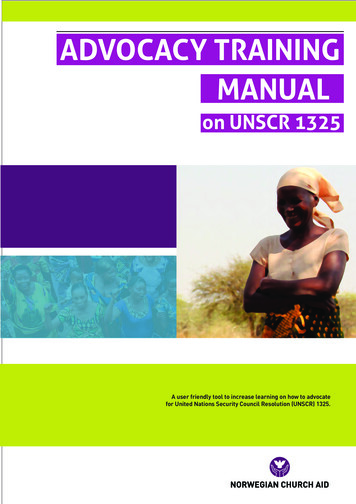
Transcription
ADVOCACY TRAININGMANUALon UNSCR 1325A user friendly tool to increase learning on how to advocatefor United Nations Security Council Resolution (UNSCR) 1325.
ADVOCACY TRAININGMANUALon UNSCR 1325First Publication 2016Funded by Norwegian Ministry of Foreign AffairsA user friendly tool to increase learning on how to advocatefor United Nations Security Council Resolution (UNSCR) 1325.Tel: 254-20-4452465/6/7, Fax: 254-20-4452468, AACC building off Waiyaki way, Westlands, Nairobi.
FOREWORDUnited Nations Security Council Resolution1325 (2000) was the first formal andlegal document from the UN SecurityCouncil that requires parties in a conflict toprevent violations of women’s rights, to supportwomen’s participation in peace negotiations andin post-conflict reconstruction, and to protectwomen and girls from sexual violence in armedconflict. It is the landmark of the Women, Peaceand Security agenda. Despite wide recognition,the implementation of the resolution is farfrom being realised as highlighted in the UNSecretary-GeneralcommissionedGlobalStudy on the implementation of UNSCR 1325.The UNSCR 1325 four pillars of women’sparticipation, protection, prevention and reliefand recovery are globally largely unachieveddue to lack of political will.Norwegian Church Aid wants to bring the UNSCR1325 to the forefront of the advocacy agendathrough our work with civil society. Integratingadvocacy in development and humanitarianprogramme work ensures a stronger impact inthe communities, as rights are realised throughpolicy change.Development actors havedeveloped awareness modules and activities tosensitize rights holders, however policies havenot been changed to accommodate the UNSCR1325 recommendations. Regarding women’sparticipation in peace negotiations, the GlobalStudy on UNSCR 1325 noted that “peaceprocesses that included women as witnesses,signatories, mediators, and/or negotiatorsdemonstrated a 20 per cent increase in theprobability of a peace agreement lasting at leasttwo years. This percentage increases over time,with a 35 per cent increase in the probability of apeace agreement lasting 15 years.”[1] Hence thenecessity to influence decision makers to takemeasures to implement the resolution.The manual is developed by the NorwegianChurch Aid’s Thematic Programme on theReduction of GBV in Conflict and Post ConflictSettings, funded by the Norwegian Ministryof Foreign Affairs. It is meant to build andreinforce advocacy capacities of civil societyorganisations and faith based actors to createand strengthen advocacy campaigns to demandthe implementation of UNSCR 1325 at nationaland regional levels. The manual includespractical tools for developing and improvingadvocacy strategies for the implementation ofUNSCR 1325.I hope you will find the UNSCR 1325 AdvocacyTraining Manual useful.Jan Olav BaarøyDirector for International Programmes[1] Statistical analysis based on a dataset of 181 peace agreements signed between 1989 and 2011. Laurel Stone, “Quantitative Analysis of Women’sParticipation in Peace Processes,” Annex II in “Reimagining Peacemaking: Women’s Roles in Peace Processes.”1Advocacy training manual on UNSCR 1325
INTRODUCTIONThe purpose of this manual is to have a user friendly and practicaltool for faith based actors to increase learning on how to advocatefor United Nations Security Council Resolution (UNSCR) 1325Women, Peace and Security agenda. This tool will mainly benefit faithbased actors; mainly Norwegian Church Aid (NCA) and partners, but alsoother stakeholders who would like to use the manual within their ownconstituencies.This manual is structured in five modules, from understanding UNSCR1325 to building an advocacy strategy on UNSCR 1325 and monitoring theadvocacy strategy, and each module is divided in sessions to be used asit fits the training goal. Sessions of the manual are built around practicalexercises, tools, handouts and notes for the facilitator. The exercisesare the core of the training as they will take the participants through aninteractive learning process that favors understanding and ownership.The tools introduced are meant to assist the users in analyzing andunderstanding a context, building a well-oriented and efficient advocacystrategy and monitoring advocacy initiatives. All tools are introduced tothe participants through exercises because putting them in practice isthe best way to understand how to use them. Tools as well as handoutsare annexed to the manual. Handouts contain either tools or essentialinformation to be distributed to the participants to take back with them.Most of the handouts are annexed but some handouts are to be developedby the facilitator prior to the training and adapted to the audience and thepurpose of the training.The training manual on UNSCR 1325 is mainly to be used by trainers butit can also be introduced to the trainees in a “training of trainers” (ToT)purpose or as guidelines to advocate for UNSCR 1325.The training manual is a living manual that can be updated and adapted tothe global context. It will be reviewed after one year of rolling out.2Advocacy training manual on UNSCR 1325
CONTENTSForeword.1Introduction.2Abbreviations.4How to use the manual.5Introductory session.6Module 1 UNSCR 1325.7Session 1: Understanding the international normative system.7Session 2: What is UNSCR 1325?.8Session 3: UNSCR 1325 reflecting Christian teachings.9Session 4: UNSCR 1325 reflecting Islamic teachings.11Module 2 Advocating for UNSCR 1325.13Session 1: What is Advocacy?.13Community mobilization and change of policy.14The different levels of advocacy.15Session 2: Why advocating for UNSCR 1325?.16Module 3 Assessing the Policy Environment related to UNSCR 1325.19Session 1: What is a policy assessment?.19Session 2: Implementation of UNSCR 1325.20Session 3: Stakeholders and power analysis.21Module 4 Develop a 1325 advocacy strategy.24Session 1: Linking the different levels of advocacy.25Session 2: Network and coalition building.26Session 3: Identifying a common goal related to 1325.27Session 4: Identifying Targets.30Session 5: Messaging.32Design a Message.32Channel a Message.33Module 5 Implementation plan.34Session 1: Advocacy activities.34Lobby.35Media attention: oral or verbal.36Mobilisation .36Identifying the most adequate activities.36Session 2: Monitoring advocacy.37Monitoring policy implementation.37Monitoring advocacy impact.37Monitoring and Evaluation.38Module 6 Overcoming difficulties/challenges in advocacy.40Session 1: Advocacy in difficult political contexts.40Session 2: Risk Analysis.41Session 3: Handling resistance towards gender issues.42Handouts.46Tools.823Advocacy training manual on UNSCR 1325
ABBREVIATIONSCBS Contextual Bible StudiesCS Civil SocietyCSO Civil Society OrganisationDDR Disarmament, Demobilization and ReintegrationGBV Gender Based ViolenceNAP National Action PlanNCA Norwegian Church AidRAP Regional Action PlanSV Sexual ViolenceToT Training of TrainersUN United NationsUNSCR United Nations Security Council ResolutionWPS Women, Peace and Security4Advocacy training manual on UNSCR 1325
HOW TO USE THE MANUALThe following manual is a simplifiedtool to help you organize an advocacytraining on UNSCR 1325. It is a set ofmodules, sessions and exercises to be pickeddepending on the purpose of the training.Objectives: each module starts with “learningobjectives” that should be introduced at thebeginning of the module and then revisitedagain with the participants at the end ofthe module to assess their achievement.Each session starts with “specific learningobjectives” which indicate the purpose and the content of the session. The learningobjectives help the facilitator to decide on which modules and sessions he/shewill focus the training. In order to organize an appropriate training, it is advised toassess the participants’ needs prior to the meeting.Times: indicative times are given on the beginning of each module, each sessionand each exercise. The given times for modules and sessions are indicative as timewill fluctuate depending on the picked sessions and exercises. One can choose amodule without going through all sessions, and similarly one can choose a sessionwithout going through all exercises. Once again, the training must be adapted tothe purpose and the time given. Only the time allocated for the different exercisesare consistent whatever the training format.Exercises: they are the most important component of this manual. There are 32exercises to create interaction between the participants and the facilitator and tolearn in an interactive and enjoyable way. Some exercises require the facilitatorto prepare in advance, these cases are indicated in the sub-section “prior to thetraining”.Items: each exercise lists items needed so the facilitator can come prepared.Notes for facilitator: the training manual is punctuated with “notes for facilitator”which are tips and recommendations for the facilitator while preparing andfacilitating the training.For each training, the facilitator should prepare a “resources” handout gatheringuseful resources such as websites, tools, books, journals, etc. related to thecontent of the training for the participants.The facilitator must adapt the training to the context, the audience and the needs.He/she can also decide to add external components to his training such aspresentations, discussions and exercises if he/she judges it useful.5Advocacy training manual on UNSCR 1325
INTRODUCTORY SESSIONBefore entering the core of the training, it is important to spend some time onan introductory session.The participants of the workshop might not know each other yet. Therefore,it is suggested that the facilitator shortly introduces him- or herself and asksthe participants to introduce themselves, saying their names, the organizationthey represent, their role within the organization and potential complementaryinformation that the facilitator judges relevant.Then, the facilitator introduces the workshop. It is advised that the facilitator asksthe participants themselves to share their expectations for the training and to writethem down on a large white paper sheet that will stay on the wall all along thetraining. Ideally, the facilitator will ask the participants to share their expectationsprior to the training and build on them to prepare the training. Then, the facilitatorshares the objectives of the training that he prepared on a white sheet of papernext to the previous one. Throughout the training, the facilitator can refer to theparticipants’ expectations and the training objectives to adapt his/her facilitation.The training can start.6Advocacy training manual on UNSCR 1325
MODULE 1 UNSCR 1325This module focuses on understanding UNSCR 1325.It is divided in 3 sessions:oooSession 1: What is UNSCR 1325?Session 2: UNSCR 1325 reflecting Christian teachingsSession 3: UNSCR 1325 reflecting Islamic teachingsLearning objectives: Understanding UNSCR 1325 and following resolutions Being able to refer to and explain UNSCR 1325 and following resolutions Identifying the roots of UNSCR 1325 principles in religionTime: 3h - 4h30Note for facilitator: throughout the training manual, UNSCR 1325 or 1325 will refer to UNSCR 1325 andfollowing resolutions. You should also make it clear with the participants to the training.Session 1: Understanding The International Normative SystemSpecific learning objectives: Understanding the legal value of various international normative instruments Understanding the value of various women’s human rights international instrumentsTime: 30-45 minutesNote for facilitator: while a variety of international instruments to ensure women’s human rights havebeen developed, including treaties, declarations, resolutions, etc, their legal strength and value vary.Considering the complexity of the international normative human rights system, it is necessary to takethe participants through a brief overview of the variousinstruments available, specifically through norms relatedto women’s rights. Only after this brief overview you willbe able to discuss UNSCR 1325 with the participants.Through the following exercise, participants willdevelop and deepen their understanding of theinternational legal framework related to women’srights.Exercise 1: Women’ human rights international framework7Advocacy training manual on UNSCR 1325
Exercise 1: Women' human rights international frameworkItems: flipchart, marker pen, handout 1"International normative instruments "Time: 30-45 min.1. Ask the participants to identify international instruments for women's rights2.Give marker pen to the participants and ask them to write their answers on theflipchart3.Review each instrument written down and ask the participants to give more detailsabout the content and the legal value of the instrument4.Distribute the handout 1 international normative instruments and read it aloud withthe participants5.Ask the participants if they want to correct the details they gave about the legal valueof the instrumentsSession 2: What Is UNSCR 1325?Specific learning objectives: Understanding UNSCR 1325 (2000) context Understanding UNSCR 1325 pillars Understanding the complementarity of following resolutions: UNSCR 1820,1888, 1889, 1960, 2106, 2122, 2242Time: 1h-1h45For more information on UNSCR 1325:- ‘Implementation of the UN Security Council Resolutions on the Women, Peace, andSecurity Agenda in Africa’ online course, UN Women for Peace Operations TrainingInstitute, 2nd edition 2014- UNSCR 1325 and following resolutions, other relevant UN documents:http://www. -and-security/The following exercise draws the context which prepared the adoption of UNSCR 1325 in 2000.Exercise 2: Understanding the context of UNSCR 1325Items: blue-tack, board, marker pen, handout 2 “Development of WPS agenda”Time: 45-60 min.Prior to the training:1. Write on single cards each policy, treaty or event that is in the handout 2“Development of WPS agenda” without the date and the description. Write onseparate single cards each corresponding date.2.Prepare a chronology with the cards with dates on the wall.During the training:1. Distribute the cards to the participants (depending on how many participants areattending, distribute one card per person or per group of persons).2.Ask the participants one by one to read their card aloud.3.Ask the participants to place the cards on the board in a chronological order and todescribe in a few words what it is.8Advocacy training manual on UNSCR 1325
4. Review and correct the chronological order with the participants, explaining the newaspects of Women, Peace and Security brought by each treaty, policy or event.5. Distribute the handout and read it with the participants. Answer potential questions.The following exercise will take the participants through the different aspects of UNSCR 1325 andfollowing resolutions.Exercise 3: What are UNSCR 1325 and following resolutions?Items: Handout 3 “UNSCR 1325 & following resolutions – long version” or handout 4“UNSCR 1325 & following resolutions – short version”, flipchart, marker penTime: 15-45 min.1. Write “what is UNSCR 1325” on a white sheet of paper.2.Ask the participants to give key words or group of words.3.Write all propositions without discussion.4.Highlight relevant key words or group of words.5.Distribute one of the handouts “UNSCR 1325 & following resolutions” – long or shortversion depending on how much details you want to give to the participants – andanswer potential questions.Session 3: Unscr 1325 Reflecting Christian TeachingsThis session was developed by Rev. Dr. Lydia Mwaniki (Ph.D), Director of Theology, Family Life andGender Justice Department in All Africa Conference of Churches.Specific learning objectives: Identifying similarities between bible teachings and UNSCR 1325 principles Being able to relate faith to UNSCR 1325Time: 1 hourNote to facilitator: UNSCR 1325 reflectsChristian teachings. The Bible containsnumerous Scriptures that serve asbiblical basis for gender justice, women’sparticipation in leadership and decisionmaking forums, prevention and protection ofwomen from GBV. Faith actors can use thesepassages as advocacy tools for UNSCR 1325.However, the facilitator needs to know thatalthough there are several biblical passagesthat promote gender justice, there are othersthat teach that women are inferior to men.These texts especially in the New Testamentwere born in their own contexts of the9Advocacy training manual on UNSCR 1325
Jewish, Greek and Roman cultures, where female was not equal to male. Examples are: 1 Corinthians11:3, 7; 1 Corinthians 14: 34-35; 1 Timothy 2:11-12; and Ephesians 5: 22-24 among others. Jesus inhis ministry broke these social and cultural barriers in his endeavor to create a community of equals.However, unfortunately, these texts that create gender inequality are the ones that are mostly used todiscriminate against women in Christian circles, more than the liberating passages. In this session, weare interested in texts that promote gender justice which reflect the egalitarian spirit of UNSCR 1325.Through the following exercise, the participants will be introduced to religious texts that eitherpromote gender equality, women’s participation or protection from GBV.Exercise 4: Emphasizing Biblical religious texts promoting gender justiceItems: Bible (optional), handout 5 “Biblical texts promoting gender equality”, handout6 “Biblical texts promoting participation of women in power structures” and handout 7“Biblical texts that protect women from GBV.”Time: 60 min.The facilitator can decide to go through one text for each theme or to focus on one or twothemes only according the audience and the time. He/she can also decide to distribute thehandouts to all the participants or not.1.Identify one biblical text that promote gender equality and read it with theparticipants. Reflect on the text with the participants. Examples of texts that promotegender equality can be found in handout “Biblical texts promoting gender equality.”2.Identify one biblical text and/or characters from the Bible that promotewomen’s participation in power structures and reflect on it with the participants.Examples can be found in handout “Biblical text promoting participation of women inpower structures.”3.Identify one passage from the Bible that protect women from GBV and explain it to theparticipants. Examples can be found in handout (Biblical texts that protect womenfrom GBV.”4.Allow discussion time with the participants. However, facilitate the discussion so theparticipants stick to the topic, respect each other and let each other talk. Bear in mind thatthis kind of exercise can create a lot of discussions, you must be able to temper theparticipants.5.Ask the participants if they know one or several other texts in the Bible promotinggender equality, women’s participation and/or protecting women from GBV and if theywould like to share them with the group.Other resources relating gender equality, women’sparticipation and protection from GBV to Christian faith:- Tamar Campaign- Created in God’s Image10Advocacy training manual on UNSCR 1325
Session 4: Unscr 1325 Reflecting Islamic TeachingsThis session was developed by Abukar Haji Aden and Ahmednaji Bashir Mohamed in consultationwith Islamic religious scholars.Specific learning objectives: Identifying similarities between Quran teachings and UNSCR 1325 principles Being able to relate faith to UNSCR 1325Time: 1 hourNote to facilitator: UNSCR 1325 reflects Islamic teachings. TheQuran contains numerous Surah that serve as Islamic basis for genderjustice, women’s participation in leadership and decision-makingforums, prevention and protection of women from GBV. Many Hadithsalso contribute and promote gender justice. Faith actors can use thesepassages as advocacy tools for UNSCR 1325.Through the following exercise, the participants will be introducedto religious passages that either promote gender equality, women’sparticipation or protection from GBV.Exercise 5: Emphasizing Islamic religious textspromoting gender justiceItems: Quran (optional), handout 8 “Islamic textspromoting gender equality”, handout 9 “Islamic textspromoting participation of women in power structures” andhandout 10 “Islamic texts protecting women from GBV.”Time: 60 min.The facilitator can decide to go through one text/story for each theme or to focus on one ortwo themes only according the audience and the time. He/she can also decide to distributethe handouts to all the participants or not.1.Identify one Islamic text that promote gender equality and read it with theparticipants. Examples of texts that promote gender equality can be found in handout“Islamic texts promoting gender equality.”2.Identify one Islamic text and/or one character from Islamic history that promoteparticipation of women in power structures. Examples can be found in handout“Islamic texts promoting participation of women in power structures.”3.Identify one Islamic text that protect women from GBV. Examples can be found inhandout “Islmamic texts protecting women from GBV.”4.Depending on the audience, you can decide to read the texts/stories that you identifiedor from handouts with the participants or you can decide to let the participantsidentify and share texts/stories that promote gender equality, women’s participationor protect women from GBV with the rest of the group first.11Advocacy training manual on UNSCR 1325
5.Allow discussion time with the participants. Facilitate the discussion so theparticipants stick to the topic, respect each other and let each other talk. Bear in mindthat this kind of exercise can create a lot of discussions; you must be able to temperthe participants.At the end of the module, review the general learning objectives with the participants andallow a discussion time to ensure that they are complete.12Advocacy training manual on UNSCR 1325
MODULE 2ADVOCATING FOR UNSCR 1325This module focuses on understanding advocacy in general and advocacy related to UNSCR 1325specifically. It is suggested to divide this module in 2 sessions:Session 1: What is advocacy?Session 2: Why advocating for UNSCR 1325?Learning objectives: Share a common understanding of advocacy Understanding the necessity to advocate for UNSCR 1325 Building capacities to advocate for UNSCR 1325Time: 2 – 3 hoursSession 1: What Is Advocacy?Specific learning objectives: Sharing a common understanding of advocacy Understanding “change of policy” and implementation/practice as the final goal ofadvocacy Understanding the multi-level structure of advocacy Understanding the importance of linking the different levels of advocacyTime: 1h – 1h15Note for facilitator: The perception of advocacy can vary from one participant to another and allparticipants may have more or less knowledge about what advocacy is. Despite the many definitions,it is important that all the participants share a common understanding of advocacy, especially if theparticipants are developing a common advocacy strategy.Exercise 6: What is Advocacy?Items: flipchart, marker penTime: 15 min.1. Write “Advocacy” on a flipchart.2.Ask participants to sharewords that come to mindwhen they think of advocacy.3.Write all responses on theflipchart without discussion.4.Identify and highlight key words or group of words related to the definition that youplanned to share with the participants.Share the definition of advocacy you chose.5.Advocacy is a process to bring about change in thepolicies, laws and practices of influential individuals,groups and institutions.NCA Advocacy Handbook13Advocacy training manual on UNSCR 1325
COMMUNITY MOBILIZATION AND CHANGE OF POLICYNote for facilitator: Advocacy is always about seeking change and we need to distinguish betweenadvocacy activities and advocacy goals. Many do not make the difference between communitymobilization and advocacy. It is important to stress change of policy or law as the final goal of advocacy.Capacity building and community mobilization, including awareness raising, sensitization and informationsharing, among other things, are important tools when used strategically. They can be used to equiprights holders and move public opinion, which can again change political decisions, transform harmfulcultural practices or other structural injustices. However, they are not goals in themselves.The following exercise will help the participants to understand the difference between communitymobilization and change of policy, and to question the goal of their advocacy activities – change ofpolicy or not?Exercise 7: From community mobilization to change of policyItems: projector, white or black board, penTime: 45-60 min.This exercise will be achieved with the help of the below tool 1 “Reflecting on peacepractice”.1. Project the tool as presented below without explanations and ask the participants tofill the boxes with the advocacy activities related to 1325 developed by theirprogrammes/organizations.2.After 15 min reflection, ask a volunteer to present his/her work.3.Help the participants to debrief on the presentation. It is expected that the downboxes related to the “socio political level” will be poorly filled.4.Explain the tool and how to use it to ensure that advocacy initiatives are effective.TOOL 1: REFLECTING ON PEACE PRACTICESHow to use the tool?1. A good advocacy initiative should have activities in all boxes, especially in the “socio-politicalboxes”.2. Read carefully the explanation of More people, Key people, Individual/personal level and Socio-political level.3. Activities should be placed in the tool according what changes they are aiming at and who theyare targeting. Four combinations are possible:a. More people and individual level: the activity aims at changing beliefs, behaviours and attitudesand targets large numbers of peopleb. Key people and individual level: the activity aims at changing beliefs, behaviours and attitudesand targets people deemed critical to the issuec. More people and socio-political level: the activity aims at changing policies and/or institutionsand targets large number of people, e.g. targeting vote behaviour, organizing petitions,conferences on the political aspect of the issue, etc.d. Key people and socio-political level: the activity aims at changing policies and/or institutions andtargets people deemed critical to the issue, e.g. lobbying for a concrete policy initiative, sideevent to an international hearing process, policy documents to disseminate among key decisionmakers, etc.14Advocacy training manual on UNSCR 1325
4. The arrows symbolize the interactions and links between the different boxes, therefore betweenthe dif
ADVOCACY TRAINING MANUAL A user friendly tool to increase learning on how to advocate. for United Nations Security Council Resolution (UNSCR) 1325. on UNSCR 1325. ADVOCACY TRAINING. MANUAL. First Publication 2016. Tel: 254-20-4452465/6/7, Fax: 254-20-4452468, AACC building off Waiyaki way, Westlands, Nairobi.
